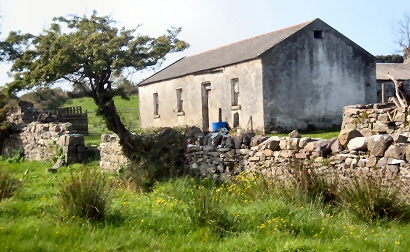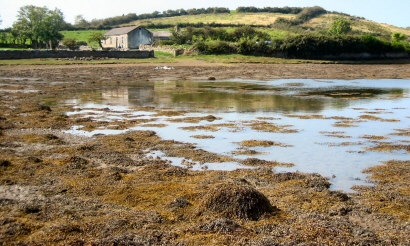Say “Nim”.
And “foamer”.
Then “nigher”
Nim-foamer
Nim-foamer nigher.
Nim-foamer nigher.
Then add a “kull” at the end.
Nim-foamer nigher-kull.
Good, now we have the right pronunciation for “nymphomaniacal”.
As in “Nymphomaniacal Alice”.
It’s the first line of the only limerick that I know. But if you pronounce the first word wrongly, it doesn’t work.
Nymphomaniacal Alice
I was thinking about this as I drove out of Galway City this morning. The importance of rhythm in writing. The train of thought began this morning because I was thinking about the rhythm of limericks, which in turn had come from my driving through the eponymous Irish city.
Nymphomaniacal Alice
Used dynamite sticks for a phallus
Oops, I should have mentioned that this is a rude rhyme. Perhaps I should have waited until after the watershed at 9pm before typing it. If you’re under 16, go and ask your mum whether it’s alright to continue.
So.
Nymphomaniacal Alice
Used dynamite sticks for a phallus
They found her vagina
In North Carolina
And her arse-hole near Buckingham Palace.
Galway City is a grand town. One of those alternative, happening places that make you pine for your youth, whoever he may be. Street entertainers, pavement cafés, pungent clouds of marijuana, tiddly lecturers hectoring their students about Joyce over a few pints of Guinness. I must email the Galway Tourist Office with my idea for a slogan:
I hadn’t intended stopping there, but it was getting dark as I drove through it, so my thoughts turned to a bed for the night. I parked up and had a wander round for five minutes before deciding that this’ll do nicely. My kind of place.
None of the hotels I tried could offer me a reasonably priced bed, so I ended up in a B ‘n’ B in Salthill, near the beach. I’ve always been rather wary of B ‘n’ Bs since that place in Wales all those years ago with the hairs in the bath. I’ll pass over that story. The usual hazard is chintz saturation, but this one wasn’t too bad. It had the regulation jolly, laughing leprechaun ornaments and the lucky shamrock samplers, but at least it was en suite, and had a TV to block out the noise of the copulating Italians in the next room.
I dumped my bags and went for a wander through the town. Irish pubs are more fearsome looking than their English counterparts. Darker, older, scruffier. Until you get used to their special ambience, you tend to walk into one assuming that you will never re-emerge. I tend to glance back at the world before the door shuts, for one last, lingering, affectionate look.
The first place I went into had a jukebox playing crackly Irish showband hits from the 1950s, and a collection of likely lads leaning on the bar, grinning at me. I took it for granted that these were sadistic “well look what the wind’s blown in” grins as they reached for concealed blades, and that I’d be savaged within seconds… but no. No, they turned out to be just sort of “welcome, friend” grins. Quite disorientating for a minute or two as I waited for my first pint of Irish Guinness to ascend to the bar top.
The second place was a classic chaotic, warren-type hostelry with a melange of nutters and clowns and intellectuals and musicians. Part Hieronymous Bosch, part Hogarth, part House of Commons. I grinned for an hour in this place, absorbing more Guinness, chatting to a bunch of students about how terrible the world is. And how wonderful.
On the way home I called in at the Shamrock Shanghai Takeaway for some greasy noodles and a large spring roll. Confirmation that the health drive was once again in reverse gear. Worse things happen at sea.
And the sea is where I find myself now, scribbling in this notebook, sitting on a grassy bank a few feet above the Atlantic. I’m in Newport, County Mayo. It’s a rugged stretch of coastline, almost unbearably beautiful. The tide is out now, and on the rocky shore below me, I see crabs among the clumps of seaweed, and hundreds of shells. Like the sky, the distant sea is a translucent, aquamarine blue. The sun is still out, just.
This is a small peninsula extending into the ocean. Behind me is an incline, and a hundred yards or so apart, are three unremarkable buildings. Unremarkable to you at least, but not to me.

One of them, invisible from here, just over the other side of the slope, close to the other shore, is a cowshed. Before 1954 it was a small house in which my mother, her 6 siblings and their parents lived. The two houses visible from here are bungalows. The one on the right belonged to my grandparents, and is still lived in by an aunt and uncle. The other one was built by another aunt and uncle about 5 years ago, and here my mother and father are staying at the moment. I can’t tell you how potent this spot is for my family and for myself. So I’ll leave you to imagine that.
Along the opposite shore are one or two whitewashed cottages stuck on the hillside. “Who lives over there?” I asked my uncle earlier. “Oh, that’s the IRA man”, came the answer. “Don’t worry”, he added, “He’s retired now”.
Beyond those hills is a fearsome sight: The Reek. The very name used to fill me with dread when I was a child. Outsiders know it as Croagh Patrick, the mountain from which the eponymous saint is said to have banished all the snakes of Ireland. It’s a ubiquitous landmark in this part of the country. Sometimes you see the tiny white box on the top that’s the church. Other times you notice that you can’t see it. At about 2500 feet, it’s not huge, but its steepness gives it an impressive stage presence.
I look up at The Reek again, and decide that tomorrow I will climb it.

